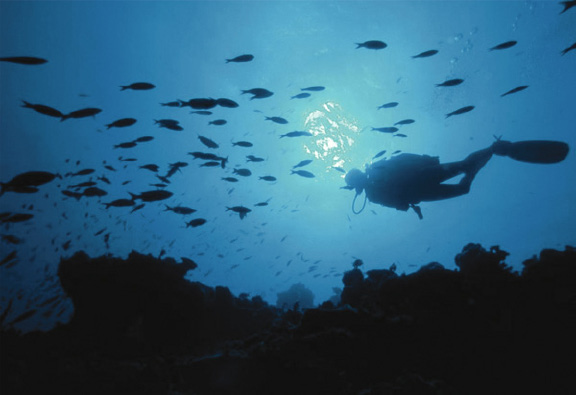
When we walk along the sea front, a river or a lagoon border, who hasn't felt the curiosity of touching the water, to feel it under your feet, to watch the animals and the plants that live in it? Even its constant rumor seems like a voice inviting us to submerge.
Men, creatures of terrestrial nature, have always seen a challenge in water, and along history, they have proved their audacity by going beyond the boundaries of the unimaginable, pursuing the hidden secrets in this, to them, an oblivious environment.
It is easy to picture that the first approaches to water bodies where similar to those of a child that dares to submerge little by little, to touch the sand, the plants, the shells and the conchs that he had first felt with his feet.
To conquer the fear of a different element was one of the biggest challenges for the first human groups, firstly moved by their curiosity and then motivated by the search of food and pieces such as corals and pearls so as to use them as decorations or for commercial exchange.
The water, even by being a constraining element to breathing and to human motor capacities, it did not stop underwater military operations, neither did it stop the recuperation of remains of sunken vessels. History shows us how underwater, but mainly at the ocean's bottom, there were enough stimuli to submerge to recuperate treasures and mysteries.

In the mural painting of Chichén Itzá (in the State of Yucatán) you can appreciate how the Mayas were able to take profit from the extensive coastline surrounding the region. The mural is witness of an efficient navigation system that allows a products exchange amongst different regions. We can also see representations of diverse aquatic fauna.
In the case of Mexico, in some of the codex where our prehispanic ancestors are represented sailing, we are able to appreciate in their drawings the knowledge they possessed on some of the aquatic inhabitants such as mollusks, crustaceans, fishes and reptiles.

The Meaning and Usage of conchs amongst the Mesoamericans
The conch, being associated with the sea, acquired magical meanings and a religious value. In the ancient towns of Mexico, conchs could represent birth or sacrifice and were considered the symbol of some godly figure, such as Tecuciztécatl, God of the marine shell. The mollusks were used as food and their conchs generated an industry dedicated to the making of ornaments, utensils, tools, weapons and musical instruments (trumpets, rattles, whistles and marimba).On top of being a raw material, the conch was used as a currency, either on its natural form or sculpted into a beaded-shape.
For example, on the mural found on the Temple of Warriors, at Chichén Itzá, Yucatán, we can see shells, crabs, rays, turtles and fish, which make their use of it as food, exchange merchandise and adornment obvious. The objects made out of a conch called spondylus, located in some of the offerings and archeological sites, are the material evidence of the underwater excursions during the prehispanic period. Nevertheless, this activity cannot be registered in any of the codex, for what we can only imagine that they had to use the basic technique of lung diving.

Ink Producing Mollusks
Mollusks, besides being a source of food, were also used to produce ink. From a certain genus of gastropods such as the Purple Murex Bandaris or the Spiny Dye-Murex the purple color, that was then traded, was extracted from, this, since ancient times, in the Mediterranean, in the East and in Mesoamerica.

Image of a yellow ray (Urolophus jamaicensis), a species frequently found amongst the archeological sunken remains.